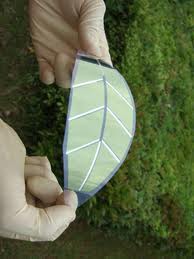
In the solar energy field researchers are using the latest developments in nanotechnology to work on very small solar cells. Researchers are testing different ways to make them more efficient. Flexible sheets of organic solar cells have entered another niche than silicon-based solar cells.
A researcher who is using nanotechnology on the active layer of organic solar cells is Dr. Daniel Ayuk Mbi Egbe, a synthetic chemist at the Linz Institute for Organic Solar Cells at the Johannes Kepler University Linz in Austria and the Coordinator of African Network on Conducting Materials for Solar Energy (ANCMSE). He is working on a material called PPE-PPV [poly(p-phenylene-ethynylene)-alt-poly(p-phenylene-vinylene)s].
“The active layer of the solar cells is composed of the donor material, the polymer, and an acceptor which is fullerene. Through our recently published article we have shown that by using other fullerenes than the widely used PCBM we have obtained higher efficiency. I have changed the side chains of the polymer in the nanometer scale. Through our systematic approach we could explain why varying certain type of side chains show very good efficiency. The nano-morphology of the active layer is very important for the efficiency of solar cells. The majority of research groups worldwide working on solar cells is studying this active layer morphology and tries to improve it,” he said.
Egbe has achieved an efficiency of four percent and is trying to find out how to improve the efficiency in general. Not only for his system, but also for other systems researchers are working on. “The efficiency of organic solar cells has already reached eight percent and commercial products are on the market,” he said.
In October 2010 the Germany-based company Helitek in collaboration with the Institute of Applied Photophysics (IAPP) at Dresden University announced that they had reached a world record efficiency of 8.3 percent for organic solar cells.
It is not Egbe’s present goal to compete with silicon solar cells; instead he sees a complementary aspect. “Organic solar cells are not as stable as silicon-based solar cells, but there is a market niche which is open for them. For instance, they can be used not only on bags, so you can charge your laptop and cell phone while walking, and in windows, but on clothes because these organic cells are flexible. It’s also possible to synthetically tune the color of the used photoactive material which cannot be done with silicon-based solar cells,” he said.
The advances in the field of nanotechnology for solar energy are changing the way we charge our electronic devices and are opening up new possibilities for people in areas without electricity.



